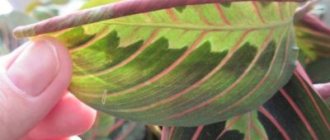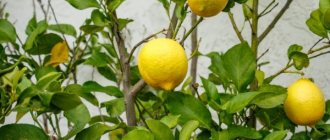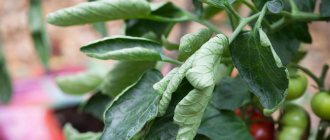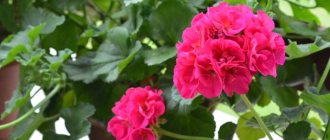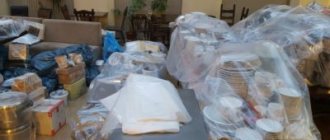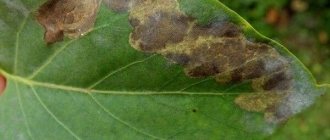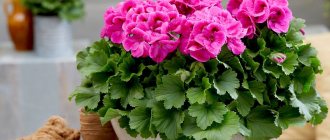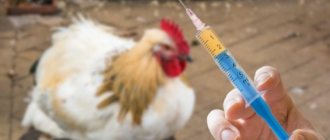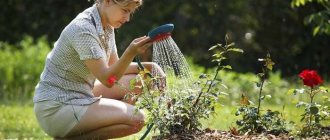Geranium or pelargonium is a beautiful flower that gardeners have increasingly purchased recently. This is often due to the particular unpretentiousness of the plant, as well as its resistance to many types of diseases. The latter is possible due to the fact that the leaf blades contain phytoncides and alkaloids - protective components (and they are very bitter) that repel many pests. Beginning flower growers, knowing that the flower does not need much care, actively plant it and breed it, decorating the window sills of their own apartments.
However, having noticed that geranium leaves curl inward, gardeners begin to shrug their shoulders in bewilderment as to how and why this could happen. This will never happen with a healthy flower, and if this is the case, then it is necessary to understand the reasons for the curling of the leaf plates and methods for eliminating the problem.
Errors in watering
Lack of moisture, as well as its excess, harms the flower. Experienced gardeners note that it is better not to top up the plant than to overwater it. It tolerates drought much better. At the same time, if it was noticed that the leaves of the geranium are curling up, this indicates that the roots have not seen water for a long time. Many novice flower growers, in principle, water the garden incorrectly - they poured water into the pot and that’s it. And if the soil inside is stone and has not been loosened for a long time, then it will be difficult for liquid to seep inside and reach the root system. The water will remain on the surface until it evaporates. To prevent this from happening, you should loosen the soil well at least once a month and make sure that the water remains on the tray after watering.
Sometimes curling of pelargonium leaves is a signal of root rotting. The problem is especially relevant in winter, when the room is cool, and people forget to reduce the frequency of watering after summer. If this is the case, then it is necessary to remove the rotten roots (if any) and completely replace the soil mixture.
Why do geranium leaves curl and dry out, what to do about it
Pelargonium (house geranium) is a plant of the geranium family. Very common and decorates many window sills. Easy to care for and suitable for beginner gardeners. However, failure to comply with certain conditions immediately affects the appearance. A very serious sign is yellowing or curling of leaves.
Reasons why geranium leaves curl
To begin with, the flower is examined in order to understand the cause of this phenomenon and begin to eliminate it as quickly as possible.
The error can occur at any stage of plant care:
- Wrong choice of soil.
- Poor or excessive watering.
- Incorrect temperature and air humidity.
- Lack or, conversely, excess of fertilizers.
- Damage by pests and viruses.
Improper watering
The condition of geranium leaves directly depends on the amount of moisture received. Trying to retain liquid inside itself, the plant reduces the size of the leaf blade. On average, watering should be done every 3-4 days in the summer, during which time the top layer of soil becomes dry.
https://www.youtube.com/watch?v=KEDg_jnssww
You need to water with clean, settled (for 1-2 days) water at room temperature. To soften it, add lemon juice or acid. Per liter 2-3 drops or 1 gram.
Hard water contributes to the accumulation of excess calcium in the soil and causes yellowing.
Excess water also has an adverse effect on the condition of greenery. The leaves change color, their edges dry out, the plant rots or becomes lethargic.
To prevent this from happening, when planting, you need to remember about the drainage at the bottom of the pot. Loosening the soil at least once a month will help the roots receive oxygen more easily.
And the liquid will better pass into the lower layers of the soil and be discharged through holes in the bottom without stagnation.
In the autumn-winter period, geranium is dormant, so it needs to be watered less often, 2-3 times a month. If the plant nevertheless begins to shed leaves and the roots rot, the solution would be to remove the damaged roots and completely replace the soil in the pot.
Soil selection, errors in fertilizing
For planting, you can buy special or universal soil in the store. Or compose it yourself.
The main condition is that the soil should not be hard and heavy, the flora should be neutral or slightly acidified. Mandatory components are sand and peat.
As the soil depletes, mineral fertilizers are applied. Particular attention is paid to nitrogen, which is responsible for the formation of greenery and abundant flowering. The leaves will be the first to signal its deficiency by becoming thin, yellow and faded.
Also, a change in color may be due to:
- Boron deficiency.
- Calcium deficiency.
- Lots of potassium.
Excess fertilizing is also harmful, so it is necessary to choose the right fertilizers and carefully measure the doses indicated in the instructions for the drug. Optimal schedule: once every 2 weeks.
If the plant was recently transplanted, it needs to be fed after two months.
Some gardeners plant geraniums in open ground in the summer. In the fall, when transferring to a pot, it is better not to take soil from the garden bed, in order to avoid infection by fungus or pests. It is optimal to purchase ready-made soil in a store.
Incorrect conditions of detention
Due to incorrect humidity and temperature indicators, short daylight hours, tight or too loose containers, the leaf plate changes its shape or color.
Lighting
Pelargonium loves well-lit window sills. But it needs to be shaded from direct sunlight, because of which the leaves will get burned. In the winter-spring period, on the contrary, the flower is placed in the sunniest place.
Temperature
In autumn and spring, it is better to keep pelargonium on a glazed balcony. The main maintenance condition is that the air should not be very cold +10…+12 °C.
Optimal indicators:
| Season | Temperature |
| Summer | +20…+25 °C |
| Winter | No more than +14 °C |
Humidity
Geranium does not tolerate air dried out by heating devices. To avoid leaf falling, it is better to purchase a humidifier or use a spray bottle. But you need to spray the liquid not on the plant, but at some distance from it. A container of water or wet expanded clay placed nearby will also solve the problem.
It is better to place the pots away from radiators and ventilate the room once a day. But this must be done carefully, because the plant does not like drafts. It also loses moisture from the surface of the leaves, causing them to curl.
Tight pots
The container in which pelargonium grows should not be small. If the roots become crowded, this will affect the appearance of the foliage. It will begin to dry out and lose color. If the pot is large, then the forces will be directed to the growth of the root system, but the flowers will not appear soon.
A plant planted in a container that is not the right size is replanted. This must be done carefully, because yellowing of the foliage can be caused by damage to the roots.
If the pot is changed during the flowering period, the flower stalks are removed.
Pests and diseases
Geranium is rarely affected by pests due to the bitterness of the juice, but there are those that still settle on the stems and greens. For example, a spider mite, it can be seen with a magnifying glass on the back of the leaves, which are covered with a transparent cobweb, dry and curl inward.
Two more dangerous parasites: whiteflies and aphids, which feed on sap. The drug Marathon or folk remedies (solutions of onions, tomato or potato tops) help fight them.
You can prepare an infusion from a head of garlic and a liter of boiling water, let it sit for a week, dilute it with water at the rate of 50 grams per 10 liters and spray the leaves.
To cope with these pests, it is necessary to treat the plant with an insecticide.
For example, Akarin, Fitoverm, Molniya, Vertimek. It is better to do this several times at intervals of 5-7 days.
And they are also affected by viral diseases, for example, leaf bacteriosis. Characteristic signs will be not only curling leaves, but also brown spots resembling a mosaic. Wilting even affects the stems. It is impossible to cure such an infection, so it is better to dispose of the flower in order to preserve the health of the plants around it.
If the root system is damaged by rot, when replanting, treat with a solution of potassium permanganate of medium concentration, pink color, for 15-20 minutes. For disease prevention, once every six months and as a top dressing no more than once every 14 days. When pouring crystals into water, it is difficult to calculate the grams and focus better on the resulting color of the solution.
Mr. Summer Resident advises: how to avoid curling of geranium leaves
It is much easier to prevent a dangerous disease than to fight it. Therefore, the main advice will be prevention.
Measures to prevent curling and yellowing of leaves:
- Regular but not intensive watering.
- Mandatory plant inspection and pest control.
- Optimal temperature and humidity indicators.
- Comfortable and cool wintering. Regular ventilation of the room.
- Timely feeding. Strictly follow the instructions and adhere to the doses indicated on the drug labels.
- Choosing a suitable pot and a bright window sill without direct sunlight.
- In the warm season, take it out into the fresh air.
By following the recommendations and creating optimal conditions for growth, even a beginner will grow healthy pelargonium at home, which will delight you with abundant flowering and caps of dense greenery. After all, a strong plant is much less susceptible to viruses and pest attacks.
Source: https://MrDachnik.com/u-gerani-sohnut-listya
Lack of feeding and fertilizer
Poor soil is an indicator of the condition of the flower.
When making up the mixture yourself, you should remember that it should be light and loose. Peat and river sand must be present in the soil. In addition, it is important to add a little humus and mineral fertilizers. After a while, the soil will begin to deplete, so it will be necessary to fertilize. Otherwise, the leaf blades may begin to turn yellow and curl.
Nitrogen plays a special role, providing good flowering and rich green color to the leaves. Its deficiency leads to the fact that the leaves become thinner, curl and wither.
Important! If fertilizing has been applied, and the situation only gets worse, perhaps the reason lies in the oversaturation of the soil with fertilizers.
There must be moderation in everything. The same applies to fertilizing. By leaving the geranium alone for a while, the flower will recover after a while.
If pelargonium was transplanted into the ground for the summer, and with the arrival of autumn the gardener returned it to the pot, while the soil was taken from the garden bed, most likely there are earthworms in it or some larvae remain. All this will negatively affect the condition of the plant, so it must be replanted again, but as a soil mixture you will need to take either special soil purchased in a store, or compose it according to all the rules. Sometimes the soil is affected by a fungus, which can be seen by a characteristic coating on the surface of the flower pot. In this case, you also cannot do without replacing the land.
Reasons why geranium leaves curl
Geranium is famous for its unpretentiousness, but sometimes gardeners still notice that the leaves of the plant curl and turn yellow. To avoid this phenomenon, before buying a flower you should study the simple rules for caring for pelargonium.
Incorrect planting or transplantation
The reason why they turn yellow and gradually die may lie in the wrong pot. If a container is chosen that is too small, especially for an adult plant, then the geranium may not have enough volume for root development. But when choosing a flower pot, it is important not to overdo it - if the container size is too large, all the flower’s strength will be spent on root growth, and you will not see flowering soon.
If the pot does not suit your flower or it does not have enough drainage, you should immediately replant it. If pelargonium blooms at this time, then all flower stalks must first be removed. When replanting, act as carefully as possible, since yellowing of the foliage can be caused by damage to the roots when “moving” to another pot.
Incorrect lighting
Geranium is a light-loving plant, but in summer, during hot midday hours, you need to shade the plant from the scorching rays of the sun. The appearance of dry spots on the leaves may indicate sunburn.
In this case, place the flower on a windowsill that does not receive direct sunlight. In winter and spring, geraniums usually lack light, so they should be moved to the sunniest window in the house.
Mineral deficiency
Leaves may curl due to a lack of various substances. Even if the plant was planted in soil rich in microelements, their amount in it quickly decreases.
Geranium must be fertilized regularly using complex mineral fertilizers. This is especially true during the growing season, when pelargonium spends a lot of energy on growth and formation of inflorescences. But it is worth considering that excess nutrients also have a detrimental effect on the appearance of the flower, so they should be added according to the instructions on the package.
Air temperature and humidity
Too dry air is not good for pelargonium, so it should be placed away from heating appliances. If there is insufficient air humidity, you can place a jar of water or wet expanded clay next to the plant.
Choose a place protected from drafts, to which geraniums are very sensitive. It is important to ensure that the temperature in the room does not fall below 10 - 12 °C. In the autumn and spring months, it is better to keep the plant on a glassed-in loggia if the temperature there does not fall below the specified level.
Violation of watering rules
If the water for irrigation is too hard, calcium accumulates in the soil, and geraniums signal this by yellowing of the leaf blades. Therefore, you only need to water the flower with water that has been standing for several days, to which you can add a few drops of lemon juice. In the warm season, you need to water the plant more often, making sure that the earthen ball does not dry out.
Excess moisture also negatively affects the condition of geraniums. In addition to curling of the leaves, in this case the lower leaf plates rot and the entire plant becomes lethargic. Experienced flower growers say that it is better to slightly underwater geranium than to overwater it, since it tolerates drought better than stagnant moisture.
Watering should be moderate, especially in winter. At least once a month, the soil must be loosened for better air access to the roots of the plant.
Loosening is also necessary so that moisture can better reach the root system: if the soil in the pot is “stony,” then even abundant watering will be less effective.
As a result, the leaves curl up, which is how the geranium tries to reduce water consumption.
But too much moisture is also bad. To prevent water from stagnating in the pot, when planting it, be sure to put a layer of drainage on the bottom of the container. Expanded clay, which can be purchased at flower shops, is ideal for this.
Diseases and pests
Geraniums can be attacked by spider mites, causing the edges of the leaf blades to curl inward. This pest is very small, so to identify it, the leaf blades must be examined from both sides through a magnifying glass.
Sometimes whiteflies and aphids settle on plants. To control insects, wash the plant and treat with an insecticide.
It is better to carry out several treatments at a certain interval indicated on the package with the drug.
More dangerous is a viral infection, in which the leaves become deformed and become gnarled. If the plant is affected by this attack, it is better to throw away the geranium to prevent infection of other indoor flowers.
A whitish coating or spots on the leaf blades indicate a fungal disease, the infection of which can also be accompanied by leaf curling. If you notice this phenomenon, the geranium should be urgently sprayed with Bordeaux mixture. After this procedure, the spots will begin to disappear, and the leaves will return to their original shape.
If root rot occurs, the plant cannot be helped; it will have to be thrown away. To prevent the roots from rotting, maintain moderation in watering.
Pests may initially be found in soil collected from a garden or park. There may be larvae of various insects, earthworms, etc. Therefore, it is better to buy soil in specialized stores.
The following drugs are effective for pest control:
- Aspirin. It is dissolved in water in a ratio of 1 tablet per 10 liters. Leaves should be sprayed once a month.
- Marathon. It helps against whiteflies and aphids. The dry substance should be scattered around the geranium, then watered well. Treatment is carried out once every 30 days.
- Messenger. Dissolve in water according to instructions and use to water the plant.
- Monterey. Effective when caterpillars appear. It must be dissolved in water and sprayed over the entire plant.
Soil composition
The optimal soil for geranium is neutral or slightly acidic; the composition should contain peat and river sand. If you make the soil mixture yourself, using soil from the garden, then disinfect the soil and add humus and mineral fertilizers.
The edges of the leaves dry out
If dry areas appear on the edges of the leaf blades, then this was due to one of two reasons:
- Pelargonium experiences moisture deficiency due to lack of watering or because the pot is in too hot a place.
- The root system of the plant is damaged. Try to replant the flower, but before planting it in another container, treat the roots in a solution of potassium permanganate. To avoid having to buy a new plant, just in case, cut off the cutting and root it in water. Be sure to disinfect the tool you will use for cuttings first.
Prevention
It is much easier to prevent leaf curl than to deal with it later. Preventive measures are as follows:
- Sufficient but moderate watering.
- Optimal temperature and humidity conditions.
- Regularly check the plant for pests.
- If possible, create coolness for the flower in winter.
- Regularly feed with complex fertilizers for flowering plants. There is no need to deviate from the instructions for the fertilizer so as not to create a deficiency or excess of minerals in the soil.
- The correct choice of pot, the size of which must correspond to the size of the root system.
In order for the plant to feel good, do not forget to take it out into the fresh air in warm weather, and regularly ventilate the room in cool weather.
Source: https://rastenia.info/tsvetyi/geran/pochemu-zakruchivayutsya-listya.html
Dry air and excess sunlight
Pelargonium is a light-loving plant, but at the same time it is afraid of direct sunlight. In the summer, it is especially important to place the flower pot as far as possible from the windows. If this was not done, you will notice that the geranium leaves have begun to curl downwards. In addition, burns may appear on the leaf plates. Dry air will not cause burns, but the leaves will suffer.
In the winter season, pelargonium should not be placed near heating devices; in the summer, it should not be placed near “southern” windows. To prevent the flower from suffering, it is advisable to irrigate it daily in the heat. In the absence of such an opportunity, you can place a bowl of cold water or ice next to the pot. Ideally, purchase a humidifier.
Prevention
It is easier to prevent any disease than to treat it. Pelargoniums are no exception. To prevent leaf curling, the flower needs to be provided with the following care:
- when planting and annual replanting, you need to use soil purchased in specialized stores; in the case of independently preparing the substrate, it is necessary to pre-disinfect it;
- ensure normal watering - the earthen ball should not dry out, but excess moisture should not be allowed;
- place geraniums in well-lit places, but avoid direct sunlight;
- protect the flower from drafts.
- maintain the air temperature in summer at a level no higher than +25 degrees, and in winter – no lower than +10 degrees;
- promptly replant the geranium into a pot of suitable volume.
The prevention of diseases in geranium is described in the following video.
Inconvenient or small potty
Choosing the wrong pot is a mistake most gardeners make. Some believe that the container should be voluminous so that the flower does not feel crowded and does not have to be replanted regularly. This leads to the fact that geranium either stops blooming after a while or does not bloom initially. The same problem applies to a pot that is too small. Flower growers read somewhere that frequent transplants are harmful, so they do not rush to replace the container, and at this time the roots are already sticking out of the drainage holes with all their might. The plant is cramped, and it shows this - the leaves of the indoor geranium curl up and lose their color.
Important! The pot should be changed as the pelargonium grows.
Pests and diseases
All kinds of insects are reluctant to land on the plant because it is “not tasty.” True, this does not mean that pests completely fly around the flower; some can still “settle” on geraniums. Often we are talking about spider mites. To detect parasites, you need to carefully examine the plant. You should look especially carefully at the lower leaf blades, where parasites settle. It is not difficult to notice them. We are talking about small bugs on the flower, dark spots on the leaves, holes in them and similar deviations that should not exist.
If something like this was noticed, it means that “uninvited guests” have visited the geranium. The most important thing is to notice the problem in time and begin to fix it. Today there are a number of drugs on sale that effectively fight a number of parasites. These are insecticides or chemicals. After treating the flower several times, not a trace of pests will remain.
How to make a flower grow and develop
The flower will grow and bloom only where it is comfortable. If geraniums have provided all the necessary conditions, then there will be no problems with it.
The plant needs:
- Provide nutrients; lack of nutrition will cause geraniums to wilt.
- Keep away from drafts. Cold air flow will negatively affect flowering and the general condition of the plant. Its roots may freeze and rot.
- Water regularly, but do not overwater it. In winter, the frequency of watering is reduced to several times a month.
- Replant from time to time, choosing a pot of the appropriate size.
In addition, it is very important to take preventive measures. If a transplant is planned, and it was decided to make the soil yourself, then all components must be sterilized. This measure will protect against “uninvited” guests and various bacteria that may be contained in individual components. The flower should sometimes be checked for pests. Dry air negatively affects the plant, so you need to take care of its moisture.
By properly caring for pelargonium, you can admire its amazing flowering and the richness of the leaf blades for a long time.
Why do geranium leaves turn yellow and what to do about it?
Beginning gardeners often encounter a phenomenon where strange changes occur with geraniums. They are especially noticeable on the leaves of the plant - they curl, turn yellow, crumble, or become covered with blisters that look like burns. What is the reason? It turns out that the mystery lies in the specific preferences of this flower, which not everyone knows about.
Causes of yellowing leaves and how to deal with it
Many people mistakenly consider geranium (pelargonium) to be an unpretentious flower, but sometimes, in contradiction to this, geranium begins to “be capricious.” One of the signs of geranium disease is yellowing of the leaves. There are many reasons for this, and here are the main ones:
- inappropriate container size;
- excessive watering;
- unsuitable climatic conditions;
- excess nitrogenous fertilizers.
Some gardeners are sure that the cause of yellowing is a lack of space for developing roots, and the flower will do well if it is transplanted from a small pot into a large container. This is not entirely true, as this can also lead to yellowing of the leaves. The best option is if the pot is about 20 cm in diameter and 15 cm in height.
Another reason for yellow leaves is excessive watering. Signs of waterlogging are immediately noticeable: rotting of the lower leaves or their lethargy. Geraniums like dry soil, although you don’t want to overdry it either. To get rid of the negative effects of excess moisture, just add drainage to the pot and regularly loosen the soil.
Pelargonium requires special treatment in winter. At this time, it is necessary to create conditions so that the flower does not stand in drafts and is away from hot steam heating radiators. The optimal temperature is no higher than 14°C, so you should find a suitable cool room. Watering at this time should also be moderate.
The use of nitrogenous fertilizers also contributes to the yellowing of geranium leaves. There is a rule: in the summer, the flower should be fertilized with potassium, and in winter it is better not to fertilize it at all. Recommendations on the amount of fertilizing are written on the fertilizer packaging, and they must be followed.
Why do geranium leaves curl and what to do about it?
Sometimes the leaves of the flower begin to curl. This is also a sign of plant disease. The reasons may be the following:
- A small pot in which the root system of the flower is cramped. For treatment, you need to transplant it into a larger container.
- Sometimes the plant gets sick due to frequent watering or, conversely, due to excessive dryness of the soil when the pot is on the windowsill above a hot steam heating radiator. Adding drainage to the bottom of the container helps prevent waterlogging, and if the soil is dry, then you should find a cooler place for the flower.
- The reason for twisting can also be infection of the plant by a fungus. In this case, spots and a whitish coating appear on the leaves. Bordeaux mixture can be used as a treatment here, which is used to treat the entire upper part of the plant.
Why do geranium leaves dry out and how to deal with it
The cause of drying leaves in pelargonium may be the following disorders:
- nutrition;
- heat;
- lighting;
- glaze.
Dry soil
Many flowers suffer from a lack of moisture, and although geranium can get by with a minimum amount of water in winter, in summer it can get sick and die without watering. This can be avoided by introducing drainage into the soil, moderate watering and loosening the soil.
Excess sunshine and heat
Geranium is a heat-loving plant.
In the summer, she loves good lighting, but if she is left for the whole day under the scorching rays of the hot southern sun, this will cause the plant to become diseased and the leaves on it will begin to crumble and fall off.
This is a sure sign that it is time to move the pot of pelargonium to some less lit place. This necessary measure will save your pet from excessive sunbathing.
Do not forget that even in winter, pelargonium can face troubles from excess hot and dry air from hot steam heating radiators.
If a pot of flowers is on the windowsill, and the room is too hot, there is reason to wonder why the leaves suddenly began to curl. The treatment in this case is simple: the pot needs to be moved to another location.
Why do geranium leaves dry out at the edges?
If the leaves of the plant begin to dry out at the edges, and areas of a brownish tint appear on their tips, it means that the air in the room is too dry.
This disease can also be caused by other factors:
- the plant suffers from insufficient watering or is oversaturated with moisture;
- the room temperature is high or too low;
- the leaves can be affected by drafts, which geranium does not like;
- there is an excess of minerals in the soil.
To identify additional reasons why geranium leaves began to dry at the edges, you should pay attention to other changes in the plant:
- Brownish spots and small dry spots have formed on the leaves, which means they lack moisture.
- If the spots are brownish and wet, then you have gone too far with watering.
- Some areas of the leaves look like blisters, which means that the reason for this is pests.
How to provide geraniums with proper care
To prevent the plant from getting sick, pay more attention to it. This flower does not require specific conditions, but this collection of tips for proper care will still be useful to you:
- The plant loves the sun, but at noon it should be put in the shade so that it does not get burned.
- If there is not enough lighting, the leaves noticeably reduce color saturation and fade. Place the pot on the windowsill and preferably on the sunny side.
- If you decide to place geraniums outside, choose a closed place without wind or drafts.
- In summer, the ideal temperature for a flower is +18 ─ +20 degrees. In winter, it should not be lower than +10 degrees.
- The plant does not require high humidity and tolerates any air well. Just keep an eye on the soil moisture; you don't need to wet the leaves.
- Pelargonium should not be replanted frequently; it is better to do this 2-3 times a year, depending on the root system. If you want to replant the plant, first select a pot of the appropriate size. Too big will not do, it will only harm the plant. In a large container, the plant will take root until it fills its entire volume, and you will never see flowers.
- A small pot is also not good. This threatens numerous ailments for the plant. In medium-sized containers, geraniums will feel more comfortable, they will have many flowers and they will look healthy and beautiful.
- You can place several pelargonium bushes in one flowerpot. Then the roots will not rot and the plant will not suffer due to unsystematic watering.
How to care for indoor geraniums (video)
From the video you will learn how to properly care for geraniums, how to feed them and what to do if the plant becomes sick.
Following these simple recommendations for caring for this capricious plant will help you make pelargonium more resistant to diseases and delight you and your family with its beautiful and bright flowers and green leaves.
We also recommend reading the article about why orchid leaves turn yellow.
Source: https://pochemu.pro/pochemu-zhelteyut-listochki-u-gerani/
